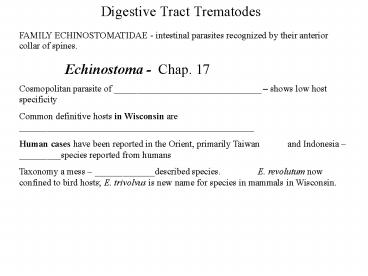Digestive Tract Trematodes PowerPoint PPT Presentation
1 / 27
Title: Digestive Tract Trematodes
1
Digestive Tract Trematodes
FAMILY ECHINOSTOMATIDAE - intestinal parasites
recognized by their anterior collar of spines.
Echinostoma - Chap.
17 Cosmopolitan parasite of ______________________
__________ shows low host specificity Common
definitive hosts in Wisconsin are
__________________________________________________
_ Human cases have been reported in the Orient,
primarily Taiwan and Indonesia
_________species reported from humans Taxonomy a
mess _____________described species.
E. revolutum now confined to bird hosts E.
trivolvus is new name for species in mammals in
Wisconsin.
2
Morphology of Adult Echinostoma
Adults are elongate, up to an inch in
length. Characteristic structure is
____________________________________________
______________________ Internal organs are
distinct and easy to identify.
3
Morphology of Adult Echinostoma
Collar of spines around oral sucker
uterus
Vitellaria Testes Mehlis
gland Ovary
4
Life Cycle of Echinostoma
Parasite shows low host specificity throughout
cycle 1. Adults occur in _________ ____________
____________________________ 2. Eggs are
released via the feces into an aquatic
habitat. 3. Miracidia hatch, swim to snail,
and penetrate ________________________(1st
intermediate host).
5
Life Cycle of Echinostoma
4. Sporocysts and rediae occur within snail.
Cercariae are released. 5. Cercariae penetrate
________________________________________________(2
nd intermediate hosts) and encyst as
metacercariae. 6. Definitive host is infected
by ingesting 2nd intermediate host,
metacercariae excyst in stomach, and adults
mature in small intestine.
6
Echinostoma
How are humans infected? _________________________
_____ ____________________________________________
________
- PATHOLOGY - inflammation of the small intestinal
mucosa at the attachment site. - Symptoms are intestinal pain and diarrhea.
- Parasite is never life-threatening.
7
FAMILY HETEROPHYIDAE - family of tiny flukes in
the small intestine of fish-eating birds And
mammals. Two heterophyids are important human
parasites. Heterophyes heterophyes
Chap. 18, p. 291-292 Adults are small parasites
in the human small intestine. Distributed in the
Orient (Japan, Korea, China, Taiwan, and the
Philippines), Africa, and Asia Minor. Reservoir
hosts - ______________________________________
Parasite is a __________________________
8
Morphology of Adult Heterophyes
Adults are small, less than 2 mm in
length. Characteristic structure is the
____________________, a muscular and spinous
sucker surrounding the common genital
pore. Gonotyl is located near acetabulum. Ovary
is anterior to testes. Testes are opposite and
posterior.
9
Life Cycle of Heterophyes
1. Adults occur ________________________________
__________________________________ 2. Eggs are
released in feces and must be eaten by aquatic
____________________ (1st intermediate) 3.
Miracidia hatch in snail and undergo sporocyst
and redial generations.
10
4. Free-swimming cercariae are released from
snail and penetrate a
_____________________________ (2nd intermediate)
where metacercariae encyst in the muscle. 5.
Humans become infected ___________________________
___________________________________. Adults
mature in small intestine in 7-10
days.
11
Life Cycle of Heterophyes
Mullet second intermediate host Metacercaria in
mullet muscle
12
Pathology of Heterophyes
- ADULTS ________________________________________
_________________________________________________
_________________________________________________ - In heavy infections, the mucosa and submucosa may
become ulcerated. - EGGS can get into the bloodstream and may be
carried to the _____________________ where they
cause a severe tissue reaction called
____________________________________. - 14 of fatal heart attacks in the
Philippines
13
Heterophyes
DIAGNOSIS - Identify eggs in the feces. Eggs
are similar to Clonorchis. (We do not have
slides of Heterophyes eggs.) TREATMENT -
14
Metagonimus yokagawai
Common heterophyid trematode in humans in the
Orient (overlaps with Heterophyes), Russia, and
the Balkan countries. ADULT MORPHOLOGY - small,
less that 2 mm long Acetabulum ___________________
_________________________________ There is no
gonotyl. Seminal vesicle and seminal receptacle
are ___________.
acetabulum
15
Metagonimus
LIFE CYCLE, PATHOLOGY, DIAGNOSIS, AND TREATMENT
is identical to that of Heterophyes.
16
STRIGEOID TREMATODES - 2 families of trematodes
that inhabit the small intestine of birds and
mammals - Chapter 16, p. 247-249
Alaria
spp. Many species of Alaria occur in the small
intestine of carnivores. Alaria canis
in dogs. Alaria americana in foxes.
Alaria mustelae in mink and weasels.
Alaria taxideae in badgers (we will
examine this one in lab)
17
Morphology of Adult Alaria
- Body is divided into 2 regions
- 1.
- 2.
- Three suckers are present - ______________________
_______________________________________________ - Common genital pore is posterior.
18
Life Cycle of Alaria
LIFE CYCLE is unusual in that 3 or 4 hosts may be
involved. 1. Adults in small intestine of
carnivore definitive host. 2. Eggs in feces
hatch in water releasing miracidia that penetrate
_____________________ first intermediate
host. 3. Cercariae released from snail
penetrate a _____________________ second
intermediate host and transform into an
unencysted stage called the ______________________
.
19
Life Cycle of Alaria
4. If tadpole is eaten, frogs, snakes, mice can
serveas _________________________________________
____. Mesocercariae undergo no further
development. 5. Carnivore becomes infected by
eating tadpole or paratenic host.
20
Life Cycle of Alaria
6. ______________________ penetrate the
intestine, burrow through the diaphragm, and
reach the lungs. Here they become
_______________________ 7. Metacercariae
migrate up the respiratory tree and are
swallowed. Adults in the carnivore's
______________________
21
Pathology of Alaria infections
PATHOLOGY - Adult parasites cause severe damage
to the small intestine of
the carnivore. Often occur together in clumps.
Forebody Hindbody
22
Pathology of Alaria infections
- HUMAN INFECTION few cases involved infection
with _______________________________ - most cases involved mesocercariae migrating to
the eye - one fatal case occurred in Canada
from ingestion of poorly cooked
_____________________________ - Mesocercariae were identified
in nearly every organ
at
autopsy. - Photo shows mesocercaria
in lung
23
Uvulifer ambloplitis
is associated with
____________________________ Fish
are the 2nd intermediate host
common in
____________________________ _____________________
_______
24
Uvulifer
Adults occur in the ______________________________
__________________ (fish-eating birds). This
is the only definitive host shows
____________________________________
25
Uvulifer
Blackspot is caused by the _______________________
______ in the fish muscle and fins.
___________________________ is produced by the
fish in response to the parasite and is deposited
into the metacercarial cyst.
26
Uvulifer
LIFE CYCLE involves (1) ________________________
_______ (2) _______________________
_____________
(3) ___________________________ (only
one - shows high host specificity)
27
Uvulifer
What happens if humans eat poorly cooked fish
with blackspot?

